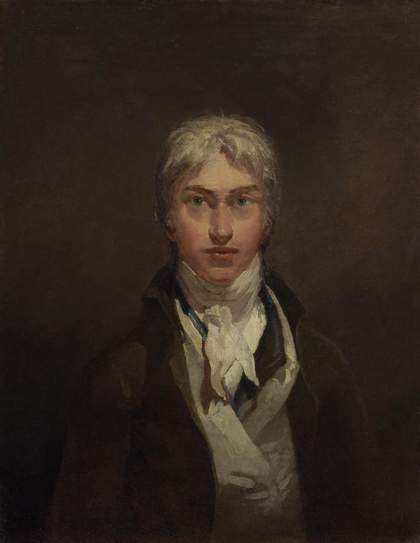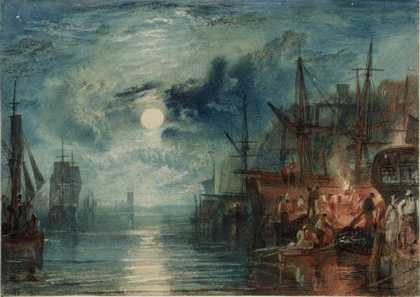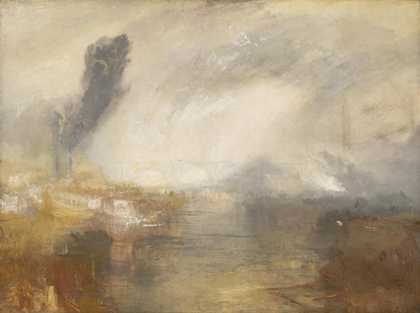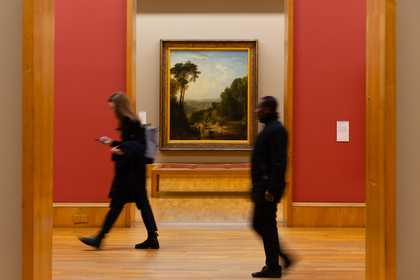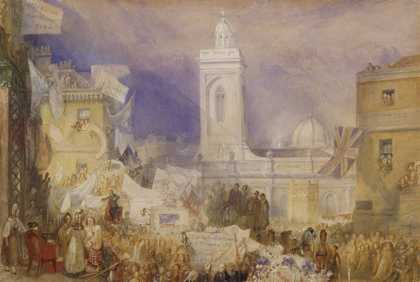
Joseph Mallord William Turner
The Northampton Election, 6 December 1830 (c.1830–1)
Tate
This exhibition explores JMW Turner (1775–1851) as an outstanding painter of contemporary life. Spanning his early architectural drawings from the 1790s to the paintings of steam power in the 1840s, it examines what it meant to be a modern artist during Turner’s lifetime.
Turner lived through revolutions, the Napoleonic Wars, the violent expansion of empires and the abolition of slavery in British colonies. At the same time, industrial development saw the construction of canals and brought machines to the workplace, while steamships and railways transformed travel.
War, colonialism and industry created immense wealth for British entrepreneurs and industrialists. Turner sold paintings to mining magnates and canal builders. He knew scientists and worked with writers, poets and publishers, who broadened his perspectives. He embraced new processes of print reproduction, which allowed his work to reach wider audiences.
Turner was unusual in depicting such a wide range of modern subjects. As well as embracing conflict and technology as themes, his work explored many social and political causes. As the world around him changed, Turner transformed his painting to capture this new environment. He used luminous colour and innovative techniques. The radical approach to paint and composition in his mature paintings show Turner paying tribute to the transformed world of modern experience.
Signs of the Time: Early Work
Turner began studying at the Royal Academy in 1789, the year of the French Revolution. His studies contributed little to his modern outlook. Students drew from antique sculpture and read Greek and Roman history. They were advised to avoid contemporary subjects. After France declared war on Britain in 1793 the British government cracked down on political activism, fearful of another revolution. Many artists were sympathetic to events in France, but rarely drew topical or political themes.
As well as observing the world he saw around him, Turner learned from established artists like his early mentor Philip James de Loutherbourg, who painted contemporay subjects. Glimpses of modern life appeared in Turner’s early watercolours of picturesque landscapes and historic buildings. First tentatively, then more confidently, he introduced industrial features like mills and foundries, and made subtle comments on current affairs in paintings of historical events.
Sketches Turner made of urban, industrial and coastal scenes during summer tours around Britain brought contemporary society into sharper focus. These were more than documentary reporting. He recorded machinery, technology and working people, but the ‘sublime’ spectacle of these new industries also sparked his imagination.
War and Peace
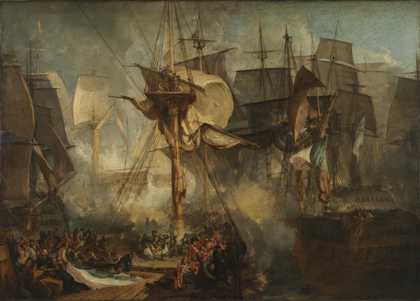
Joseph Mallord William Turner
The Battle of Trafalgar, as Seen from the Mizen Starboard Shrouds of the Victory (1806–8)
Tate
France’s new revolutionary-republican government declared war on Britain in 1793, four years after the French Revolution. Napoleon Bonaparte was crowned as the first Emperor of France in 1804, and war with France became a clash of empires and ideologies that lasted until 1815.
Turner seized the opportunities the wars gave him as a painter of modern history. He depicted conflicts that took place as far afield as Egypt and India, and British victories in the Napoleonic Wars such as the Battle of Trafalgar, which took place in Spanish waters in 1805. By the time he painted a scene from the Battle of Waterloo in 1818, three years after the conflict, his political position seems to have changed. While earlier works glorified war, Turner’s later paintings revealed a greater compassion for suffering and death among all sides and ranks.
Research for his battle pictures included site visits, conversations with survivors or drawings and records by military artists who had been present. Turner also depicted the trauma of war metaphorically through images of storms, shipwrecks and drownings at sea.
Turner was appalled by the human, social and economic costs of the long war with France and he celebrated the return of peace. Despite this, he regarded British Admiral Horatio Nelson (who died at the Battle of Trafalgar) as a national hero, and Napoleon as ‘the scourge of Europe’.
'Modern Thought': Turner and his Literary Contemporaries
Turner lived through an intensely literary age. His poems, book illustrations and collaborations with poets, writers and publishers reflected his modern interests. He saw painting and poetry as complementary. He exhibited pictures with fragments of his own poems or quotations from other authors.
Contemporary authors provided Turner with an insight into the politics and events of the time. They valued his interpretations of their work. He was in high demand, as his illustrations helped turn books into best-sellers.
Turner was selective in his response to modern writers. He knew Samuel Rogers, Walter Scott and Thomas Campbell, and illustrated their works. His favourite poet was Lord Byron, but it is unlikely they ever met. Turner made most of his Byronic images after the poet’s death.
Turner’s illustrations were reflections or meditations rather than literal or exact visualisations of particular passages of text. They drew on his own memory, travels or imagination.
Home Front
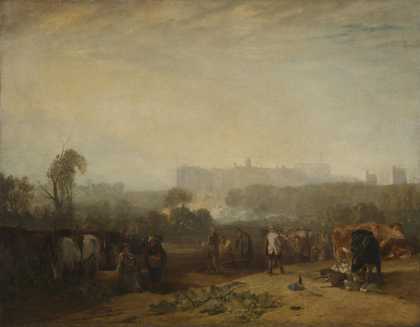
Joseph Mallord William Turner
Ploughing Up Turnips, near Slough (‘Windsor’) (exhibited 1809)
Tate
Britain was at war for most of the first half of Turner’s life. His paintings and watercolours of this time show an awareness of how Britain and its population were affected by overseas conflict. They include pictures of coastal defences against a feared French invasion, depictions of soldiers (a common sight up and down the country), and the impact of tax increases to pay for the war effort.
Turner put human experience at the centre of his depictions of different subjects. The setting of rural labourers against the background of Windsor Castle in Ploughing Up Turnips, near Slough hints at the vast inequalities in British society. At the same time, he openly courted royal patronage. In 1819, he painted the birthday of the Prince Regent (later George IV), in the hope of selling the prince the painting, and he travelled to Edinburgh in 1822 to document the king’s state visit.
A keen sailor, Turner’s passion for the waterways connecting Britain is evident in many of his watercolours and prints. His depictions of canals show his interest in them as symbols of commercial and engineering progress as well as their placement in the rural landscape. Turner’s pictures of Britain show him as a perceptive chronicler of contemporary history, fascinated by the changing face of the nation.
Causes and Campaigns
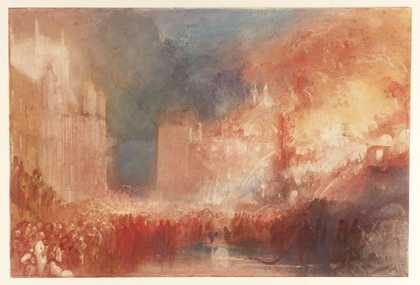
Joseph Mallord William Turner
The Burning of the Houses of Parliament (c.1834–5)
Tate
Turner was not an overtly political artist, but he became increasingly liberal during his lifetime. His works contain more references to progressive causes than any other painter of his time. These include the reform of parliament, freedom of expression, religious toleration, Greek independence from Ottoman rule and the abolition of slavery.
Turner’s outlook was very probably encouraged by the Yorkshire landowner Walter Fawkes. He was Turner’s most important patron from 1802 until he died in 1825, and they became very close friends. Fawkes’s politics were radical. He spoke against the slave trade and religious and social repression in England.
Although Turner broached these subjects in over twenty of his oil paintings and watercolours, his references to contemporary events were often subtle. The meanings may have been too obscure for most people, but they would have been noted by viewers who were engaged with these issues.
Slavery was a major part of the British economy. By the start of the nineteenth century, it is estimated that Britain had transported 3.1 million people from Africa to the British colonies in the Caribbean, North and South America and other countries. Hundreds were shackled together and packed into the cramped decks of slaving ships in inhumane conditions. Some 10 to 20 percent are estimated to have died on the journey.
The Committee for the Abolition of the Slave Trade was established in 1787 but it took twenty years to secure legislation to end the trade in 1807. It was not until 1833 that slavery itself was outlawed in British overseas territories. Emancipation for enslaved people was finally achieved in 1838, at least in principle. The British government compensated slave owners for their loss, but gave nothing to those people who had been enslaved. Although British slavery was now illegal, the number of enslaved people crossing the Atlantic increased in the 1820s and 1830s, with Brazil, Cuba and the US the principal destinations. The Royal Navy’s West Africa Squadron was charged with arresting slave ships and resettling their victims in Sierra Leone, but it had insufficient resources and was hampered by legal restrictions.
The personal fortunes of some of Turner’s early patrons came from slavery. Turner also sought to benefit from it: in 1805 he invested £100 in a proposed cattle farm in Jamaica to be worked by enslaved people. It was never realised and all the investors lost their money. Other patrons were opponents of the slave trade, among them Turner’s closest friend Walter Fawkes. Perhaps with Fawkes’s encouragement, by the later 1820s, Turner had converted to the cause of Abolition. This is shown by his dedication of an engraving to an opponent of the slave trade.
Steam and Speed
Steam power was the most conspicuously modern feature of Turner’s lifetime. It was used in industry during the eighteenth century and applied to locomotion in the nineteenth. Steam reduced journey times at home and to mainland Europe. It had such varied purposes in Britain that American writer Ralph Waldo Emerson called it ‘almost an Englishman’.
Steamboats became common in British waters in the 1820s. Turner used them regularly and often painted them. Robert Stephenson’s first steam locomotive ran on a public railway in 1825. Isambard Kingdom Brunel’s Great Western Railway, called ‘the most gigantic work… in the entire world’, was constructed in the 1830s.
Fellow artist John Constable said he thought Turner painted with ‘tinted steam’. This characterised the way Turner’s style developed alongside his subject matter. His pictures of steam power produced between 1831 and 1844 are not just documents of innovation. They register the transition from older technologies, and their elemental and mechanical energies show a world in flux. Turner suggests that coal-burning steam engines cannot wholly control the forces of nature. The pollution they pump into the atmosphere makes these forces more unpredictable.
Modern Painter
In the 1840s, Turner started experimenting with the presentation of his ideas. He used shaped formats (such as square, circular or octagonal frames), exhibited subjects in pairs and worked in more extensive series. His exploration of colour was unparalleled, and his style became increasingly adventurous. Turner was forging a new language of representation. He dispensed with the hard outlines and the artificial divisions of the visual field that characterised more traditional approaches. He also gave greater prominence to the effects of light and atmosphere. This approach chimed with the latest scientific thinking on how vision actively shapes what we experience.
The subject matter of many works from the final years of his career shows Turner’s continued interest in modern life. In addition to paintings of steam technology, he meditated on the legacy of Napoleon’s rise and fall. He also responded to current events. Perhaps prompted by the Treaty of London in 1839 that established Luxembourg’s independence, Turner visited the country that summer to make new studies. After Queen Victoria married Prince Albert in 1840, Turner painted the castle in Saxe-Coburg (now Bavaria, Germany), where the prince was born. In two unfinished oil paintings, he captured the October 1844 state visit to Britain of the French king Louis-Philippe and in one of his very last watercolours he reflected on the uprising in Naples of May 1848.
In 1843 a reviewer commented, ‘No painter of the presentday dare attempt such pictures as Mr. Turner produces.’ Art critics agreed he had developed a completely distinctive approach to painting. By the end of his career, modernity was not limited to Turner’s subject matter, it had also transformed his style and practice.

